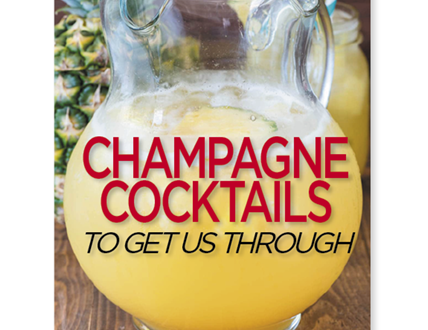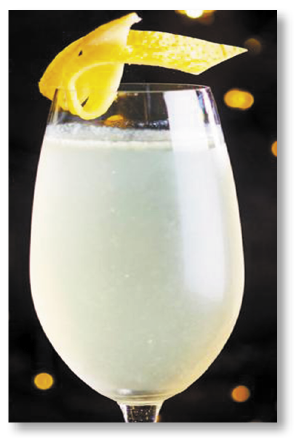CHAMPAGNE COCKTAILS TO GET US THROUGH
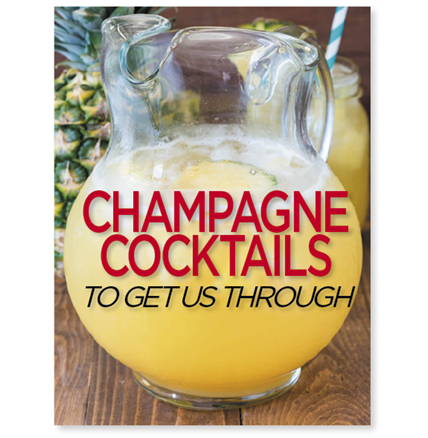 By Kirsten Amann
By Kirsten Amann
Even the soberest of men will sometimes wake up and wonder what hit him after the second highball,” wrote Virginia Elliot and Phil D. Strong in the 1930 edition of Shake ‘Em Up. They were describing a hangover in their aptly titled chapter “Comes the Dawn”, but a similar sort of WTF energy can permeate in the early days of the New Year. If this is how you’re feeling, worry not: we are in this together, and lucky for us, Champagne cocktails exist.
FOR COMMUNAL DRINKING
As discussed a few January’s ago in “The Case for the Champagne Cocktail”, no one is certain who had the bright idea to swap Champagne in for spirits in the original recipe for the cocktail (which was simply spirits of choice, sugar, water, and bitters). Champagne in punch, however, has an unsurprising culprit: “We must look to the source of that sportiest of wines,” writes David Wondrich in his 2010 book Punch: the French.
Punch is widely understood to be a sort of larger format precursor to the sour style mixed drinks we love today, classically made with spirits, citrus, water, sugar and spice, and by the late 1600s punch was all the rage in England.
Not so in France, writes Wondrich: “though Frenchmen were among the first to taste it, unlike the Germans or especially the Dutch, they maintained their distance.” It caught on by the late 18th century though “not in its unaltered form: in Paris, men and women drank and socialized together, and social drinks had to appeal to both.” Women of the day were said to be put off by the strong spirits mixture, and Champagne was swapped in as a base to democratize the drink for all.
Hopefully, you’ve had plenty of Champagne by the time New Year’s rolls around, and why not keep going? A simple 18th century recipe for Champagne Punch makes a great toast to the ball drop, and couldn’t be simpler to make.
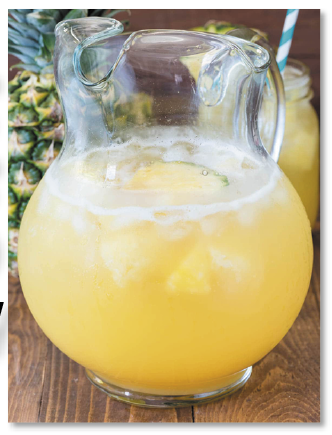 CHAMPAGNE PUNCH
CHAMPAGNE PUNCH
Adapted by David Wondrich from
Jerry Thomas’ Bar-Tenders Guide, 1862
1 QUART-bottle of wine
1/4 pound of sugar
1 orange sliced
juice of a lemon
3 slices of pineapple.
1 wine glass (2 OUNCES) of raspberry or strawberry syrup. ORNAMENT with fruits in season, and serve in Champagne goblets.
NOTES Don’t worry about the quart size, just use a 750ml bottle. Make sure to DISSOLVE the sugar first, which you can do using the juiced lemon (about 2 ounces.) “Dilution here is neither necessary nor desirable,” writes Wondrich, so if you can, use a large block of ice to chill the punch without too much watery mess.
FOR PERSONAL CONSUMPTION
Much as we might want to, the demands of late stage capitalism mean that most of us can’t wile away our hours around the punch bowl, searching for the bottom. Instead, have a French 75, a single-serving Champagne cocktail that should be top of your list of go-to drinks. I’ve lately seen the French 75 served as a brunch drink, perhaps as a line extension to the ubiquitously brunchy Mimosa? However, this drink should not be relegated to brunch, or to any other time of day. Drink these anytime and often: the drink offers elegant effervescence as a pre-dinner aperitif or even as a nightcap.
French 75s are typically served with gin, lemon, simple syrup, and bubbly, however, if you find your way to the Crescent City for Mardi Gras next month, do yourself a favor and stop at Arnaud’s French 75 Bar. Their signature version is made with Cognac and it is world famous.
The French 75, which is basically a Tom Collins with Champagne in place of fizzy water, is named for a gun, specifically the 75mm light field gun that, “due to its portability and rate of fire was the mainstay of the French army during the First World War,” writes Simon Difford in the Difford’s Guide Encyclopedia. There are earlier recipes for a different French 75 made with gin, applejack, grenadine, and lemon, but the earliest reference to the version we love today is in Here’s How, a book published
in 1927 by the humor magazine THE JUDGE. The recipe note reads: “This drink is really what won the War for the Allies.”
Kids today likely have no idea what a “soixante-quinze” howitzer is, but in the ‘20s and ‘30s, few drinks writers could resist penning a witty aphorism about this drink. Harry Craddock’s sentiments in The Savoy Cocktail Book (1930) have stood the test of time as the drink still “Hits with remarkable precision.”
1/2 OUNCE of lemon juice
1 TEASPOON sugar
2 OUNCES of London dry gin or Cognac
Chilled Champagne
COMBINE sugar and lemon juice in a cocktail shaker and stir to dissolve.
ADD gin and ice and shake to chill. STRAIN into a Champagne flute and
TOP with Champagne.
FOR EXTRA MOOD LIFTING
There’s nothing like bubbles to bring levity to any occasion, such as a 4pm sunset, the dawn of an election year, or a post New Year’s Eve party hangover. Add the refreshing, aromatic properties of a handful of mint into the mix and you’re basically an aromatherapy influencer.
The Champagne Julep is another vintage recipe that is exactly what it sounds like: a Julep style drink that swaps in Champagne for strong spirits. It first appeared in Harry Johnson’s Bartender’s Manual in 1882 as a simple mixture of loaf sugar, mint and Champagne, and a liberal array of fresh strawberries in season. Over the last 142 years, brandy has found its way into the glass in varying measures, giving the drink a bit more kick.
I recommend breaking out your Julep cups to serve this drink. We should get more mileage out of our Julep cups than just one day a year in May. Between the shiny silver serving vessel, the mood-lifting aroma of mint, and the fizz of Champagne cascading into your drink, your day is bound to feel a bit brighter.
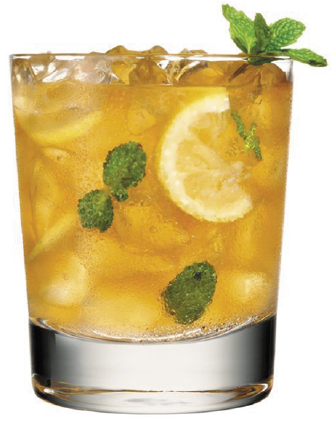 CHAMPAGNE JULEP
CHAMPAGNE JULEP
4-6 OUNCES of Champagne
1/2 ounce of brandy
1/2 ounce of simple syrup
10-12 mint leaves
Gently PRESS the mint with simple syrup in the bottom of your julep cup. FILL halfway with crushed ice, then ADD brandy, and fill slowly with CHILLED Champagne (a rushed pour will result in foam and spillage, so take your time.) Lightly STIR, top with more crushed ice, then more Champagne, and GARNISH with a robust sprig of fresh mint.
It’s January in New England which means it’s cold and dark and most of our wallets are a bit lighter post-holiday, but it won’t be this way forever. Embrace it: braced with a bit of Champagne to help get us through we’ve got this.

